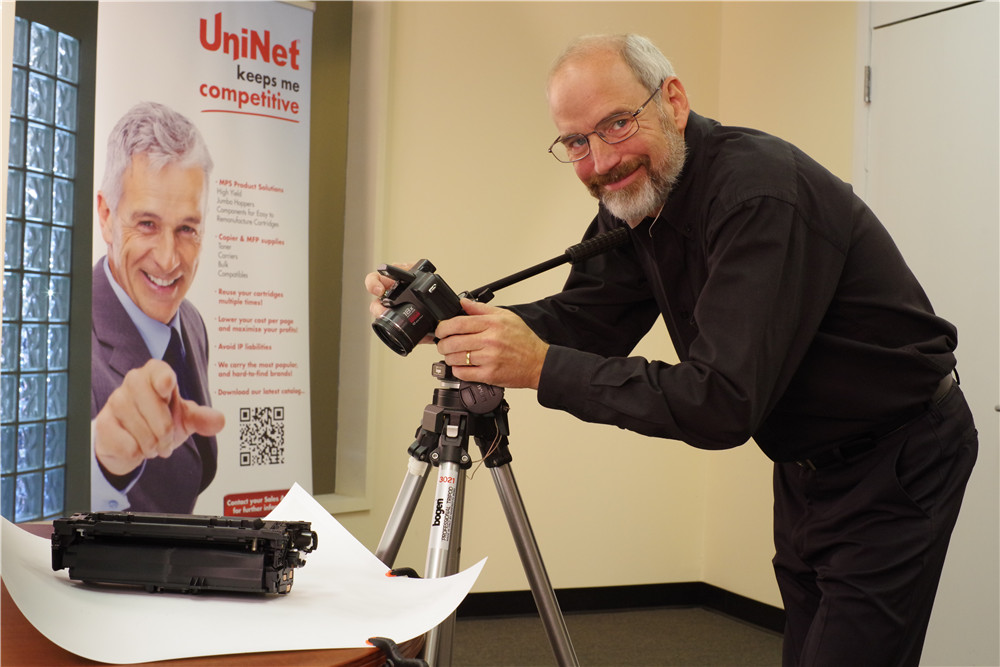The Toner Cartridge Remanufacturing Industry: Challenges and Hurdles We Have Faced
Mike Josiah discusses the technical challenges we have faced in the toner cartridge remanufacturing industry.
 When I was first asked to write this article, I started to reflect on the last 30 years and all our industry has accomplished and overcome along the way. Looking back to where we started, we have as an industry come quite a long way! As the years have gone by we have grown, adapted to market changes and reacted to social changes. While our industry is a long way from where it started, I don’t see it going away any time soon. I’m proud to have been a part for so long and look forward to the future!
When I was first asked to write this article, I started to reflect on the last 30 years and all our industry has accomplished and overcome along the way. Looking back to where we started, we have as an industry come quite a long way! As the years have gone by we have grown, adapted to market changes and reacted to social changes. While our industry is a long way from where it started, I don’t see it going away any time soon. I’m proud to have been a part for so long and look forward to the future!
When our industry first began, there was no internet and no remanufacturing aftermarket. Information on how to take a cartridge apart and remanufacture it was hard to come by. Chenesko Products (the company I started with in the industry) developed a “Fax on Demand” system where you would call in from the handset on your fax machine, punch in the document number you wanted and it would fax it back to you, all on the same call.
It may sound primitive now, but at the time it was high tech! Around the same time Chenesko produced a series of “How to” videos. All were produced using a local NY film crew on tape and (painfully!) took an average of 4-8 hours to film for each one. Those two items helped start getting remanufacturing information out there.
The first cartridges to be filled were Canon PC (A20) and HP LaserJet 92285A (CX) (see Image 1), The PC used positive toner and the CX cart’s used negative. By trial and error, it was found that there were some Canon Copier cartridges (tubes) where the toner could be dumped out and used in these cartridges to refill them. The prints were not dark black, more like a dark gray, but they worked, and saved people money. The aftermarket industry was born!
Soon after that the industry started making and selling “drill and fill” kits. At first the components in the cartridges were extremely durable and if the cartridges were cleaned out reasonably well, they mostly worked… not great, but they worked. Then suddenly the cartridge components didn’t last very long and quality became a big issue. The industry almost died before it got going.
Those quality issues and the new SX Cartridge changed the industry in that we now learned to take the cartridge apart and re-manufacture it. The SX drums failed after a few cycles, and the cartridges really needed to be taken apart and cleaned properly. The dedicated aftermarket supplier industry was born as new drums and wiper blades were now being manufactured.
Around the same period of time, IBM released the 4019 series of printers (see Image 2). They used a design completely unlike the Canon-based cartridges we had seen so far. They weren’t terrible, but they used a plastic plate to keep the gears in place, all held together with plastic rivets.
Great care had to be taken in removing those rivets, drilling holes for screws and keeping the plates with their respective cartridges. If you mixed up the plates, the gears could be misaligned when the cartridge was put back together. Some companies had jigs to help with this when drilling but it still was safer to keep the plates with the correct core.
In my opinion, the first huge hurdle from a technology point of view that we ran into was with the HP LaserJet 3Si printers (NX). At first they were fine, but then Canon/HP made a change to the PCR. The new PCR’s had a gray coating instead of the original black coating (see Image 3). This new coating barely made it through the original cycle and really never made it through a remanufactured cycle. Once they failed, the cartridge “back-grounded” and ghosted badly.
The aftermarket industry responded in a number of ways. There were systems to strip the gray coating off and recoat them, systems to place a more conductive coating without stripping the old off, and then finally the true solution… new replacement PCR’s. It was a long period of time from when the first gray PCR’s appeared and new replacement PCR’s that worked became available. The aftermarket supply industry learned much from this.
New machines continued to be released by HP and Canon, but the nice thing was that most were based on the same cartridge. The HP 3Si became the 4Si, the HP LaserJet 4 became the 4+ and then the 5. Life was good for the Aftermarket…
Other manufacturers also made their own laser engines and the field of cartridges we could remanufacture grew fast. In 1995, Chenesko Products released the first Cross Reference Guide, where you could look up a printer model number and identify the engine used. There were so many printer models available, the Guide became a necessary tool. We also started to include cartridge theory in the instructions where merited (see Image 4).
The theory wasn’t necessary to know to remanufacture a cartridge, but it definitely was good to know when a cartridge failed post testing and you needed to troubleshoot them. Another helpful tool was a comprehensive repetitive defect chart. You could measure the distance between repetitive defects and refer to chart for that cartridge. Those charts quickly helped narrow down the possible problems.
When Brother jumped into the ring in 1999, they went about things in a truly different way—as they still do (see Image 5). Their toner used a positive charge as opposed to the negative charge used in other laser printers. In addition, these units used a unique process to clean the drum, compared with the conventional wiper blade and waste chamber system. Rather than being put into a separate waste chamber, the “waste” toner—by means of a charge brush in the drum unit and a switching power supply (reverse polarity on the developer roller)—caused the toner to be drawn back into the toner supply chamber to be mixed with the new, unused toner.
New replacement toner had to be able to accept both charges, and it also had to mix well with the used toner. The toner itself had quite a few additives that helped the printing process, but also caused issues within the Aftermarket. If the old toner wasn’t completely removed from the supply chamber—when the toner cartridge was “empty” it still had approximately 80g of mostly toner additives left inside—the toner cartridge would gum up the charge brush in the drum unit which caused back-grounding and ghosting. The only way to fix this was to clean the charge felt in the drum cartridge and completely clean out all the toner in the toner cartridge and replace it with new toner. To this day, Brother still uses engines based on this initial system.
The STMC Committee was formed in 1999, at RIT (Rochester Institute of Technology). This committee continues to be actively comprised of volunteers and uses standards from ASTM, ISO, ISTA and ANSI to train companies on very strict rules for objectively testing finished cartridges. At the time the committee was formed, there were no real standards for the Aftermarket. In my view, these standards helped establish our industry as a direct competitor to the OEM. In the early days of RIT, we sent them two new OEM EX cartridges and two remanufactured EX cartridges.
One set (remanufactured and OEM) was tested using all the new standards in January (during winter) and one set in July (during summer). This was before they had access to a humidity chamber. The difference in yield and density with the change in humidity was dramatic. We always knew humidity played a part but never realized how much it actually did.
The next big challenge was in 2005… the HP Color LaserJet 2600. It wasn’t the first HP color cartridge/engine, but probably the hardest to master that we had seen. It was the first cartridge where having a complete system of parts really became important. The toner was chemically manufactured and the waste chamber was small, so the toner had to be very efficient. Color reproduction was tricky which meant the toner, drum, PCR, developer roller and doctor blade all had to work together as a system. Initially those parts were made by a number of different manufacturers to match OEM parts.
Then, as the industry learned, they were made to match dedicated aftermarket systems. There were a number of technical issues with these cartridges that made them tricky to do well. The cartridge drum end caps were not removable so the drum had to be cut, in order to be removed. There was a metal hinge pin that had to be drilled to remove a plastic locking pin that required a special screw-removing tool.
The doctor bar needed to be gapped properly. There were also a number of internal electrical contacts that were easily damaged if you were not careful. Eventually, new aftermarket waste chambers with end caps became available, as well as internal seals and blades, which greatly helped the quality on these cartridges.
The most frustrating aspect of these cartridges was that sometimes, even if you did everything right, they still had issues.
Some type of “reset” or “lock out” device was now becoming the norm for most cartridges. Some machines used chips or fuses. Others had specific reset menu commands that needed to be followed for the printer to accept the new remanufactured cartridge. To help with this, Summit Laser (new name for Chenesko Products) introduced their first version of the Reset Guide in the February 2001 issue of the Recharger Magazine.
This guide listed all the known menu commands that might be needed, and if the cartridge had a fuse, or chip. If it had a chip, it also listed whether the chip could be reset, or it needed to be replaced.
As time went on, most cartridges adopted chip technologies, but for the most part they could easily be made by the aftermarket, or in some cases didn’t need to be replaced at all.
When IBM sold off their printer division to a new company called Lexmark that started to change. When the 4069 cartridge was released, it had a chip that was very difficult, at first, to emulate. The aftermarket came up with “piggy-back” boards that used the original OEM chip, but by-passed parts of the code. Eventually, new replacement chips became available.
“Prebate” cartridges—single use cartridges that were sold at a discount with the agreement that the customer would mail them back to the manufacturer after use—had been out since the earlier 4059 cartridges. Prebate cartridges suddenly became an issue because they did not have the same chip preventing them from being remanufactured at the time.
It often seemed that each time the aftermarket made a breakthrough on the chip technology front, Lexmark would release new firmware that stopped the chips from working. The aftermarket did manage to keep up and finally beat the system.
When the T520 cartridges were released, the aftermarket world changed… It took a long time for the aftermarket to catch up with the encryption technology used on these chips. The late Lester Cornelius, a guru and advocate of the aftermarket industry called these chips “ARD’s” (Anti-Recycling Devices). Those chips were the start of what we are still dealing with today (see Image 6).
Many printer manufacturers now work with the aftermarket in chip development in order to manufacture chips that do not infringe or let the user think they had an OEM cartridge. Sadly, some printer manufacturers continue to fight us with new “ARD” type chips. These chips may be harder to legally make (not a clone) but we still get there.
A few years ago the aftermarket industry stepped up again and started creating new replacement chips that use microprocessors programmed with the appropriate encryption to speak with the printer. These chips typically have a single dedicated microprocessor on the board covered in a black epoxy for protection. These type of chips are made in huge volumes from silicon wafers and are very reliable.
The good news is while OEM cartridge technology has advanced, so has the aftermarket. The OEMs have new toner formulations, toner manufacturing methods, coatings on mag/developer rollers, and drums that can print extremely fast with a high DPI. They also use chips that are now incredibly small, fast and use very sophisticated encryption technology. The aftermarket, for the most part, has found work-around solutions as quickly as new OEM cartridges are released. The sophistication on both sides is quite high.





Leave a Comment
Want to join the discussion?Feel free to contribute!